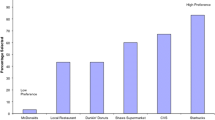Abstract
The present study evaluates the extent to which food stimuli displace leisure stimuli when they are combined in stimulus preference assessments. Four children diagnosed with autism spectrum disorder participated in the study. Multiple-stimulus without replacement preference assessments were given both before and after meals for five consecutive days. Food reliably displaced leisure items for 2 of 4 participants. For one of the participants, leisure items reliably displaced food items, while another participant had mixed results. Implications for future research and practice are discussed.



Similar content being viewed by others
Notes
There were no instances where a response was not made.
References
Bojak, S. L., & Carr, J. E. (1999). On the displacement of leisure items by food during multiple-stimulus preference assessments. Journal of Applied Behavior Analysis, 32, 515–518. doi:10.1901/jaba.1999.32-515.
DeLeon, I. G., Iwata, B. A., & Roscoe, E. M. (1997). Displacement of leisure reinforcers by food during preference assessments. Journal of Applied Behavior Analysis, 30, 475–484. doi:10.1901/jaba.1997.30-475.
Fisher, W. W., Piazza, C. C., Bowman, L. G., & Amari, A. (1996). Integrating caregiver report with a systematic choice assessment to enhance reinforcer identification. American Journal on Mental Retardation, 101, 15–25.
Higbee, T. S. (2009). Reinforcer identification strategies and teaching learner readiness Skills. In R. A. Rehfeldt & Y. Barnes-Holmes (Eds.), Derived Relational Responding: Applications for Learners with Autism and other Developmental Disabilities (pp. 7–24). Oakland, CA: New Harbinger.
Author information
Authors and Affiliations
Corresponding author
Ethics declarations
Ethical Approval
All procedures performed were in accordance with the ethical standards of the institutional research committee and with the 1964 Helsinki declaration and its later amendments or comparable ethical standards.
Informed Consent
Informed consent was obtained from the guardians of the participants prior to the study.
Conflict of Interest
The authors declare that they have no conflict of interest.
Rights and permissions
About this article
Cite this article
Andakyan, L., Fryling, M.J. & Benjamin, K. Further Evaluation of the Displacement of Leisure Items by Food During Stimulus Preference Assessments with Children with Autism. J Dev Phys Disabil 28, 461–467 (2016). https://doi.org/10.1007/s10882-016-9483-3
Published:
Issue Date:
DOI: https://doi.org/10.1007/s10882-016-9483-3




